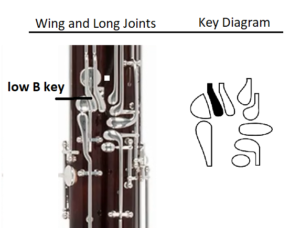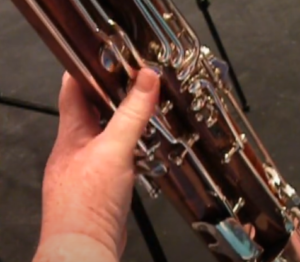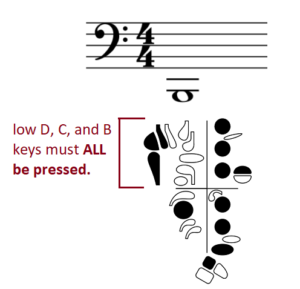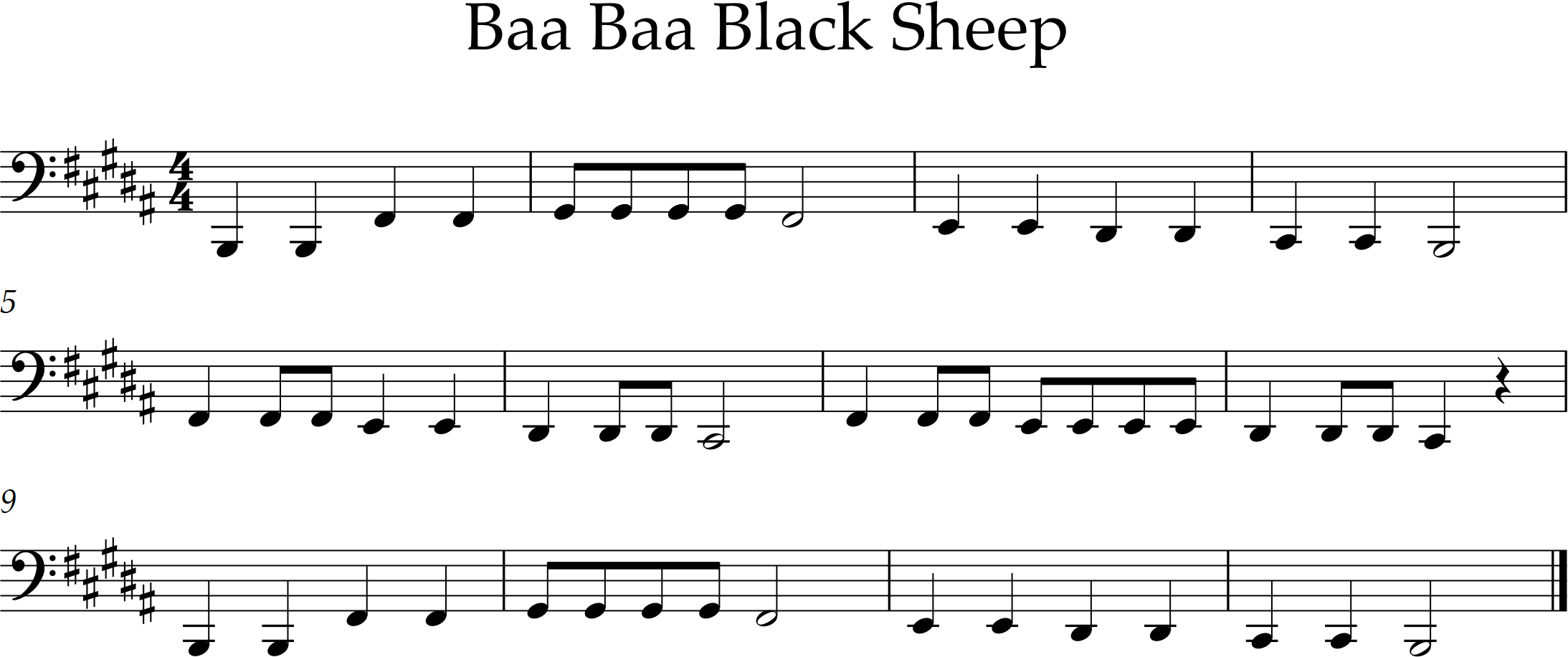The Low B key
The low B key is located on the long joint and is operated by the left thumb.


Fingering

NOTE:
The long joint mechanism is built so that the low B key connects to take the low C key down with it, and the low C key connects to take the low D down with it. If your bassoon is in excellent adjustment, you should be able to press only the low B key and have the low C and D keys go down too. However, that is rarely the case so you should plan to press all three keys when possible.
Response
Low B can be a grumpy note.
- It is more resistant than low C and low Bb
- Embouchure has to be very soft to keep the note from jumping up or splitting the octave.
- Articulation needs to be firm.

If you have trouble getting low B to speak, try the suggestions below. These suggestions apply to all low notes but need to be exaggerated on low B.
- Soaked reed
- Hot Pizza mouth
- Space the teeth
- Soft lips
- Low back of the tongue
- slow, warm, steady air
- firm articulation
- cover all tone holes completely
- low E key must press the whisper-key pad tightly against the bocal vent
- Low F, E, D, C, and B keys must be pressed
- Tip opening of the reed at least the thickness of a nickel. A reed that is too closed at the tip will not play low notes.
Intonation
Low B tends to be very sharp.
- Hot pizza mouth
- Back of the tongue as low as possible
- Most open oral cavity possible
- Most space between the teeth possible
- Less reed inside the mouth (move lips a little closer to the tip)
- If you are having trouble relaxing the lower jaw enough, try pressing down with the upper lip instead.
Matching Pitch on Low B
Play Matching Pitch on Low B to learn now open and relaxed everything has to be to get low B down to pitch.

Tone
Use the fleshy pink part of your lips to cushion (mute) the vibrations of the reed without applying upward pressure on the reed. This will dampen some of the “rowdy” vibrations on the low B.
Bee-low Notes
Keep your left hand as relaxed as possible and isolate the motion in your thumb. Use the least amount of pressure possible to fully depress the low note keys.

Baa Baa Black Sheep
B major is a challenging key so take your time learning this tune. Here is a practice plan I often use:
- I suggest breaking the tune up into pairs of notes (B-F#, F#-G#, F#-E, E-D#, D#-C#, C#-B) and practice each pair until you are comfortable, confident, and your fingers move easily
- Then create 3-note combinations (B-F#-G#, F#-E-D#, and D#-C#-B) and practice each group until you are comfortable, confident, and your fingers move easily.
- One final step for practicing the fingerings is to play the pitches in order but without the printed rhythm (B-F#-G#-F#-E-D#-C#-B, F#-E-D#-C#, F#-E-D#-C#, B-F#-G#-F#-E-D#-C#-B). Practice this pattern until you are comfortable, confident, and your fingers move easily.
- Once this becomes easy you are ready to add the rhythms and play the printed version.
Fingering Tips:
- Use the back F# and front G# for this tune.
- Both thumbs have to move for the leap from low B to F#. The left thumb will move to the whisper key and the right thumb will move to the F# key.
When moving from low D# (same fingering as Eb) to C#, the left thumb will need to move down to the low C key and the left pinky will press the low C# key (below the low Eb/resonance key).


Feedback/Errata